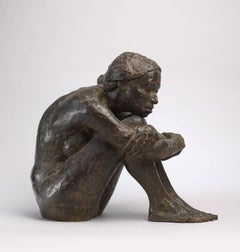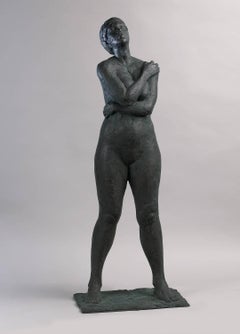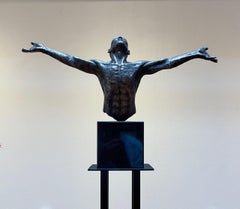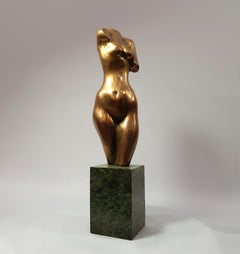Peter Brooke Nude Sculptures
American, b. 1961
Peter Brooke was born and raised in the harbor town of Scarborough in North Yorkshire, England in 1965. After earning a Bachelor of Fine Arts degree in television and film production from Manchester Polytechnic, he moved south to London and began his professional career as a sculptor and designer for Jim Henson’s Creature Shop. After moving to the United States, he began to exhibit bronze sculptures of animals. Brooke studied with contemporary masters George Carlson and Floyd De Witt. His early classical influences included Rodin, Epstein, Moore; animal portraits influenced by Rembrandt, Bugatti and Jonathan Kenworthy; also Degas and Giacometti. The skilled quality and convincing character portrayals of these sculptures were quickly recognized. His work has been shown in many museum and gallery exhibitions throughout the country. Brooke’s powerful interpretations of the human figure have also gained him notoriety. Besides his success in fine art, Brook has a successful industry career. He was a Creative Supervisor for the Academy Award-winning Jim Henson’s Creature Shop where he has completed work for films such as, “Where the Wild Things Are”, “The Producers”, “Frances”, “Cats and Dogs”, “Stuart Little 2”, “Dr. Doolittle”, and many more.
Peter Brooke resides in Los Angeles with his wife, Charlotte, and their son, George. He is also a jazz saxophonist.
Professional Memberships
Sculptor Member of the California Art Club
Awards and Honors
2004 Gold Medal Award for Best Sculpture, California Art Club’s 94th Annual Gold Medal Juried Exhibition held at the Pasadena Museum of California Art
1998 Award of Excellence, the Society of Animal Artists Annual Exhibition
Selected Press
Newspapers & Magazines: Southwest Art Magazine
TV Programs: Wildlife Art News and Art-Talk(Biography provided by American Legacy Fine Arts)
to
2
1
1
Overall Height
to
Overall Width
to
1
1
1
2
7
69
30
28
28
1
1
1
Artist: Peter Brooke
Seated Figure
By Peter Brooke
Located in Pasadena, CA
Provenance
Acquired by the gallery directly from the artist
Exhibitions
Beauty and the Power of Sculpture, American Legacy Fine Arts, October 20 - November 24, 2007
Category
Early 2000s Realist Peter Brooke Nude Sculptures
Materials
Plaster
Goddess
By Peter Brooke
Located in Pasadena, CA
Signed Edition
#1 of 6
Provenance
Acquired by the gallery directly from the artist
Description
Feeling the sun’s warmth enveloping her body, Peter Brooke’s bronze “Goddess” express...
Category
Early 2000s Realist Peter Brooke Nude Sculptures
Materials
Bronze
Related Items
"At Last, " Sculpture
By Bill Starke
Located in Denver, CO
Bill Starke's "At Last" is a limited edition, bronze sculpture created by Bill Starke depicting a male figure with out-stretched arms.
( 3/85 )
About the artist:
Human beings int...
Category
2010s Realist Peter Brooke Nude Sculptures
Materials
Marble, Bronze
Venus
Located in Sempach, LU
In this work, the author turned to classical mythology and created the image of the goddess Venus. Goddesses of youth, beauty and love. He created the classical female torso on a mar...
Category
1980s Realist Peter Brooke Nude Sculptures
Materials
Bronze
Morning
Located in Sempach, LU
The author admires the beauty of the female body. Her movement - smooth, graceful and beautiful. The moment of awakening is very sensual. The girl stretches, revealing the beauty of her young body. Realistic manner shows her original beauty. Sculpture shapes create a play of light and shadow, curves, polished and brushed metal. The work is made of bronze- polish and patina.
This sculpture was created in the early period of Alex Radionov...
Category
1990s Realist Peter Brooke Nude Sculptures
Materials
Bronze
Bronze Bust of Apollo Belvedere Grand Tour 19th Century
Located in Rochester, NY
Superb 19th century bronze and gilt bronze bust of the god Belvedere Apollo. Circa 1850. This wonderful grand tour bust is a marvel of refined beauty and elegance, crafted with richl...
Category
19th Century Peter Brooke Nude Sculptures
Materials
Marble, Bronze
Debora Lima-original figurative female dancers bronze sculpture-contemporary Art
By Andrzej Szymczyk
Located in London, Chelsea
Bronze , Limited edition of 8
"Debora Lima" stands as a captivating tribute to the beauty and grace of the human form, crafted by the skilled hands of artist Andrzej Szymczyk. This ...
Category
21st Century and Contemporary Realist Peter Brooke Nude Sculptures
Materials
Bronze
H 25.2 in W 7.88 in D 7.49 in
Model Girl
Located in Sempach, LU
Classic female torso inspired by examples of high Greek sculpture. Sculptor explores the lines and shapes of the female body, embodied the diversity, slightly changed the poses.
Thi...
Category
1980s Realist Peter Brooke Nude Sculptures
Materials
Stone, Bronze
Replica of Wilhelm Lehmbruck's Kneeling Woman
Located in Troy, NY
This sculpture is a small replica of Wilhelm Lehmbuck's Kneeling Woman. The original sculpture is much larger at around 69.5 x 56 x 27", currently at th...
Category
1960s Expressionist Peter Brooke Nude Sculptures
Materials
Wood, Plaster
Industrial Machine Age American Scene WPA Mid 20th Century 1939 SF World's Fair
Located in New York, NY
Industrial Machine Age American Scene WPA Mid 20th Century 1939 SF World's Fair
HAIG PATIGIAN (American/Armenian, 1876-1950)
Aeronautics Pediments
Two Plaster Casts, c. 1930s
each 13.25 x 14.75 x 6 inches
It's possible these moquettes were created for the 1939 World's Fair, the Golden Gate International Exhibition in San Francisco.
Provenance: Private Collection of Lois M. Wright, Author of "A Catalogue of the Life Works of Haig Patigian, San Francisco Sculptor, 1876-1950),” 1967
Loan to Oakland Museum of California (Oakland, CA)
BIO
Haig Patigian is noted for his classical works, which are especially numerous in public venues in San Francisco, California. Patigian was born in Van, Armenia, which at that time was under Turkish rule. Haig was the son of Avedis and Marine Patigian, both teachers in the American Mission School there. He and his older brother showed an aptitude for art early on and were encouraged by their parents. Their father himself had taken up the new hobby of photography. The 1880s were harsh times, however, for many Armenians under an oppressive rule by the Turkish government. Many people were fleeing to the safety of the United States. Suspicious Turkish authorities accused his father of photographing city structures for the Russian government, and in 1888 he fled for his life to America.
Haigs father made his way to Fresno, California, and began life anew as a ranch hand. Within two years he sent for his wife, as well as Haig, his three sisters and brother, and in 1891 the Patigians made the journey from Armenia. Haigs father, an industrious man, worked on various farms, and eventually bought his own ranch and vineyard. It was among fertile farmland of Fresno that Haig grew up.
Young Haigs education consisted of teachings by his parents and by intermittent attendance in public schools. Although he had dreams of becoming an artist, he did not have the opportunity for formal study of art, and began working long days in the vineyards around Fresno.
At age seventeen, Haig made a step towards his dreams and apprenticed himself to learn the trade of sign painting. In his spare time he nurtured his interest in art by painting nature and life scenes with watercolors and oil paints. When his sign-painting mentor left Fresno, Haig opened his own shop and made a name for himself in the town. San Francisco, in the meantime, had been attracting artists since the Gold Rush and had become a thriving art center. Within a few years, Haig had put aside several hundred dollars to move to San Francisco, joining his brother who was already working there as an illustrator.
In 1899, when he was twenty-three, Haig had saved enough money to enroll at the Mark Hopkins Art Institute in San Francisco. Like many aspiring artists of his time, Patigian supported himself by working as a staff artist in the art department of a local newspaper, and in the winter of 1900, nearing his 24th birthday, Haig began work for the San Francisco Bulletin, producing cartoons, black and white illustrations, as well as watercolors.
In 1902 tragedy struck Haig and his family. His 29-year-old brother died of pneumonia, and then his frail mother died a short time later. Five months more saw his youngest sister, just out of high school, die too. Saddened and depressed, Haig moved out of the studio he had shared with his brother, and into a dilapidated studio in a poor section of town. During this time of sadness, Haig fed a growing interest in sculpture.
In 1904 Haig created what he later called his "first finished piece in sculpture". The work, called "The Unquiet Soul", depicted a man thrown back against a rock while waves lash at his feet. The body was tense and twisted, with one hand, in Haig's own words, "searchingly leaning and clutching the rock, while the other masks his troubled head".
The Press Club of San Francisco, which Haig had joined in 1901, put "The Unquiet Soul" on exhibition and local headlines proclaimed "Local Newspaper Artist Embraces Sculptor's Art", and "First Work Predicts Brilliant Future". With the support of friends and community acclaim, the young illustrator left his newspaper job and became a professional sculptor.
The path of his new career was not easy though. Haig had never made much money working for the newspaper and his father needed help with growing debt from funeral expenses and business problems. From time to time Haig sold some artwork, but also occasionally borrowed from friends to pay the rent. He was the classic 'starving artist'.
In the spring of 1905 a white-bearded 81-year-old stranger knocked on Haig's door. It was George Zehndner, from Arcata, California. Zehndner had been born in Bavaria, Germany in 1824, the son of a farmer. In 1849 he had come to America looking for prosperity, settling in Indiana, where he worked on a farm and learned English. He found his way to the West Coast in 1852. Penniless, he worked in various jobs from San Francisco to Sacramento, then found some luck working in the gold fields of Weaverville in Trinity County, and eventually moving to a farm on 188 acres near Arcata. In his 77th year in May of 1901, Zahndner had taken a trip to San Jose, where he stood in a crowd to see a man he thought much of, President William McKinley. McKinley was popular as 'the first modern president' partially because he realized going out to meet the common person increased his support. In September of that year, however, an anarchist assassinated the president while he stood in a receiving line at the Pan-American Exhibition in Buffalo, New York. Soon after, the city of San Jose erected a statue of the slain president in St. James Park. Zehndner took a second trip to San Jose where he visited the McKinley monument. Touched, Zehndner decided that, no matter the cost, his town of Arcata too would memorialize McKinley.
George Zehndner had read about Haig in a newspaper article and asked if Patigian would create a heroic statue of the late President McKinley for Arcata. When asked how much it would cost, Haig responded, despite his borderline poverty, with the fabulous sum of $15,000. Zehndner agreed. The President was to be portrayed standing, wearing an overcoat, with his feet planted squarely on the ground. In the finished statue, one hand is held out before him in a typical posture of speaking, with the other hand holding the speech as his side. The 9-foot statue...
Category
1930s American Modern Peter Brooke Nude Sculptures
Materials
Plaster
Girl at Waterfall
Located in Sempach, LU
"This is one of my earliest sculptures. I depicted a naked girl at the waterfall. She bathes under jets of water. The fabric of clothing hugs her body and lies down to her feet. The ...
Category
1980s Realist Peter Brooke Nude Sculptures
Materials
Bronze
"In My Dreams I Can Fly, " Sculpture
By Bill Starke
Located in Denver, CO
Bill Starke's "In My Dreams I Can Fly" is a limited edition, cast and patinated aluminum sculpture created by Bill Starke depicting a male figure free falling through the air.
( 3/99 )
About the artist:
Human beings interacting, colliding, cooperating, striving, & achieving are the themes I wish to portray in my sculptures. My observations on the human condition are meant to be both humorous and thought provoking.
Bill Starke's "Free Man" is everything that good art should be: technically superb, brilliantly composed, emotionally powerful and visually arresting... like George Stubbs, the 18th century English...
Category
2010s Realist Peter Brooke Nude Sculptures
Materials
Other Medium
Neoclassical Nude Sculpture of a Young Bacchus by Elias Hutter 19th Century
Located in Rochester, NY
Neoclassical bronze sculpture of a young Bacchus and fawn making an offering Elias Hutter. Very fine casting with a rich patina. Early to...
Category
Mid-19th Century Peter Brooke Nude Sculptures
Materials
Metal, Bronze
"Catch of the Day " Sculpture
By Bill Starke
Located in Denver, CO
Bill Starke's "The Seeker" is a limited edition (AP 3/6), bronze sculpture created by Bill Starke depicting a contemplative male figure holding a rope with 3 climbers ascending to th...
Category
2010s Realist Peter Brooke Nude Sculptures
Materials
Metal, Bronze
Peter Brooke nude sculptures for sale on 1stDibs.
Find a wide variety of authentic Peter Brooke nude sculptures available for sale on 1stDibs. You can also browse by medium to find art by Peter Brooke in bronze, metal, plaster and more. Not every interior allows for large Peter Brooke nude sculptures, so small editions measuring 13 inches across are available. Peter Brooke nude sculptures prices can differ depending upon medium, time period and other attributes. On 1stDibs, the price for these items starts at $8,800 and tops out at $9,700, while the average work can sell for $9,250.



